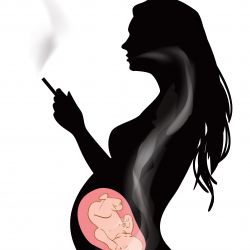Smoking is bad. Bad for mom. Bad for unborn and born baby. Now, yet another study reveals its adverse effect on the developing child.
This time the focus is the kidney and the resultant damage.
Researchers from Kyoto University in Japan set out to clarify the association between smoking during and after pregnancy in the home with the risk of proteinuria at age 3 years old of the child.
Proteinuria refers to the spilling of protein into the urine. This can occur in a benign fashion when it is in trace amounts and due to orthostatic proteinuria (aka protein appearing in the urine upon standing due to a positional or postural shift). When it is sustained and present in the urine in increasingly significant amounts, it can reflect underlying disease or damage of the kidney.
The dangers of cigarette smoking while pregnant are well-documented. Understanding the symbiotic relationship of the pregnant mother to her unborn child is vital to appreciating the impact toxic exposures can have on the baby. What mom ingests, baby ingests. What mom inhales, baby inhales. Rates of miscarriages and neonatal asphyxia are higher in this population as issues of the placenta are not uncommon. As is preterm labor and the unfortunate health sequelae of the premature baby. Poor growth in the infant (aka intrauterine growth restriction (IUGR)). Low birth weight.
Sudden infant death syndrome (aka SIDS) is linked to smoking during and after pregnancy— resulting in over 1000 annual deaths as per the Centers for Disease Control and Prevention (CDC). As are certain birth defects. Children exposed experience higher rates of ear and lung (or respiratory) infections along with asthma.
Let’s not forget the untoward heart and lung disease impact as well as cancer and stroke risk on the mother. Primary and secondary exposure to smoking cast a wide shadow of ill consequence on the developing fetus, newborn, child, mother and household contacts.
This is not news. However, there is limited study on the link between smoking and issues of the kidney or renal system in children. One pediatric report demonstrated the association of secondhand smoke and disease-range proteinuria in kids with chronic kidney disease (CKD). The correlation of CKD and smoking in the adult sphere is well-known.
The claim of this latest exploration: “Our study is the first large–sample size study to evaluate the association between childhood proteinuria in young children and maternal smoking during pregnancy resulting in passive smoking for the fetus… In conclusion, our…study on the basis of child health checkups showed that the odds of childhood proteinuria at 3 years of age was increased by 1.2-fold among those exposed to maternal smoking during pregnancy and household smoking after the child’s birth, although the association with household smoking after the child’s birth was not statistically significant. Additional research is necessary to determine the long-term effects of secondhand smoke on CKD in adulthood.” (1)
This new study out of Japan set out to explore the link between childhood CKD and smoking of the pregnant mother and as a household hazard. The investigators performed a population–based retrospective cohort study on 44,595 children acquiring the data from prenatal health checkups, home visits, and well visits at 4, 9, and 18 months and 3 years of age in Kobe City, Japan. Over 1+ urinary protein was considered relevant to this work. The prevalence of maternal smoking during pregnancy and household smoking after the child’s birth were 20% and 60%, respectively.
Standardized questionnaires informed of past (4.4%), current (16.7%) or nonsmoker (78.9%) status. Smoking status of mothers, fathers, and other family members during and after the child’s birth was also assessed.
The frequencies of child proteinuria were 1.7% in the current smoking group, 1.6% in the past, and 1.3% in the nonsmoking one. Children followed for 3 years who had proteinuria endured a higher prevalence of nonmaternal family smoking during pregnancy (46.5% versus 41.3%) and that of household smoking status after the child’s birth (61.2% versus 55.4%). Those of statistical significance were seen in maternal smoking status during pregnancy, nonmaternal family smoking status during pregnancy, and household smoking status after the child’s birth.
Does this publication substantially move the needle on this issue of the importance of smoking cessation in this population? Not really. It serves to maintain the extensive canon of research already supported by volumes of data on the dangers of smoking to all populations. Smoking while pregnant and after pregnancy still is of no benefit to those involved and does profound harm. Given that 40% of children worldwide are estimated to be exposed to household smoking, the public health risks readily abound. (2)
Identifying maternal smoking during pregnancy to be one of the risk factors of childhood proteinuria is important and not too surprising. This endeavor, however, had meaningful limitations which the authors readily disclose. The data was self-reported which can tend to understate the nature of the true habit. Absent data on relevant history regarding preeclampsia, neonatal asphyxia, and maternal alcohol use, for example, was arbitrarily deemed or recorded as disease or exposure absence. There was a diminished follow-up rate —in particular at age 3— for varying reasons.
Bottom line: Don’t smoke. If you do—no matter if pregnant or of whatever age or population, then discuss with your doctor ways to stop. It is a very challenging endeavor, but one that can genuinely yield success and improved health and well-being for you and those around you. The long and short-term gains far outweigh any drawbacks.
SOURCE:
(1) (2) Shinzawa M et al. Maternal smoking during pregnancy, household smoking after the child's birth, and childhood proteinuria at age 3 years. Clin J Am Soc Nephrol. Vol 12. 2016

